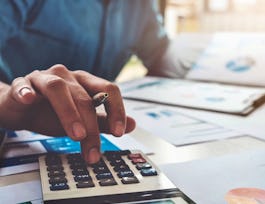In the third course, you will learn how to use information from cost accounting to improve managerial decision-making. We discuss business decisions and suggest how cost information can support them best. For example, how will costs change if managers adjust cost drivers? How many units do companies need to sell in order to avoid losses or to achieve a targeted profit? How can managers improve pricing or product programs with information from cost accounting?


Cost Accounting: Decision Making
This course is part of Cost Accounting Specialization
Taught in English
Some content may not be translated



Instructors: Gunther Friedl
4,056 already enrolled
Included with 
Course
(33 reviews)
Recommended experience
What you'll learn
You will learn methods that help to figure out how costs will behave if you adjust produced or sold quantities.
You will learn how cost information can support business decisions best.
You will learn to distinguish costs that are relevant for business decisions from costs that are irrelevant.
Details to know

Add to your LinkedIn profile
21 quizzes
Course
(33 reviews)
Recommended experience
See how employees at top companies are mastering in-demand skills

Build your subject-matter expertise
- Learn new concepts from industry experts
- Gain a foundational understanding of a subject or tool
- Develop job-relevant skills with hands-on projects
- Earn a shareable career certificate


Earn a career certificate
Add this credential to your LinkedIn profile, resume, or CV
Share it on social media and in your performance review

There are 3 modules in this course
Cost accountants want to support decision making. To do so, they should not only calculate current costs and income, but they should also be able to tell managers how costs might change depending on managers' decisions. "How would costs change if we produced more or less products? How would they change if we produce more or less variants of products? How would they change if we increase the quality of our products?" Cost functions help to answer these questions and in this module, we make you familiar with them. First, we show you some typical cost functions and, second, we introduce a variety of methods that cost accountants can use to determine cost functions. Finally, we show you how accountants can document cost forecasts.
What's included
7 videos6 readings5 quizzes2 plugins
When companies consider offering a new product, they might want to know how many units they need to sell in order to avoid losses or to achieve a targeted profit. Cost-volume profit analysis is a simple tool that helps answer these questions. It illustrates how costs, revenues, and profits depend on sold quantities.
What's included
9 videos1 reading10 quizzes1 plugin
In the beginning of this course, you learned that companies use Cost Accounting to support managers' decision-making. In this module, we outline some business decisions and discuss how cost information can support them best. For example, we discuss pricing decisions and product-mix decisions under capacity constraints.
What's included
11 videos4 readings6 quizzes1 plugin
Instructors

Offered by
Recommended if you're interested in Finance

Technical University of Munich (TUM)

University of London

Macquarie University

Technical University of Munich (TUM)
Why people choose Coursera for their career




Learner reviews
Showing 3 of 33
33 reviews
- 5 stars
84.84%
- 4 stars
15.15%
- 3 stars
0%
- 2 stars
0%
- 1 star
0%
Reviewed on Mar 9, 2022
New to Finance? Start here.

Open new doors with Coursera Plus
Unlimited access to 7,000+ world-class courses, hands-on projects, and job-ready certificate programs - all included in your subscription
Advance your career with an online degree
Earn a degree from world-class universities - 100% online
Join over 3,400 global companies that choose Coursera for Business
Upskill your employees to excel in the digital economy
Frequently asked questions
Access to lectures and assignments depends on your type of enrollment. If you take a course in audit mode, you will be able to see most course materials for free. To access graded assignments and to earn a Certificate, you will need to purchase the Certificate experience, during or after your audit. If you don't see the audit option:
The course may not offer an audit option. You can try a Free Trial instead, or apply for Financial Aid.
The course may offer 'Full Course, No Certificate' instead. This option lets you see all course materials, submit required assessments, and get a final grade. This also means that you will not be able to purchase a Certificate experience.
When you enroll in the course, you get access to all of the courses in the Specialization, and you earn a certificate when you complete the work. Your electronic Certificate will be added to your Accomplishments page - from there, you can print your Certificate or add it to your LinkedIn profile. If you only want to read and view the course content, you can audit the course for free.
If you subscribed, you get a 7-day free trial during which you can cancel at no penalty. After that, we don’t give refunds, but you can cancel your subscription at any time. See our full refund policy.


